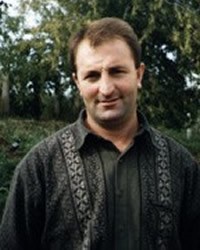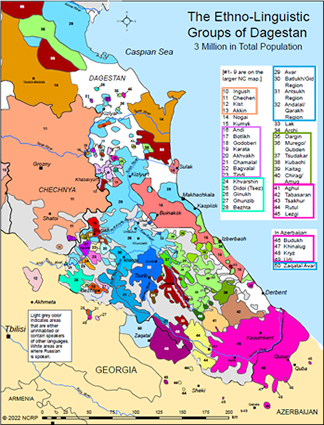The Tsakhur call themselves Iiqhy but are generally known by the name of their largest village, Tsakhur. Tsakhur history is a rich tapestry of rugged beauty and communal identity, but one also beset with tragedy and a lack of grace.
Originally, the Tsakhur lived in Daghestan, but during the thirteenth century, some of them moved north into Azerbaijan. Throughout the years, they have fought for independence from the Turks and Persians. Prior to 1850 the Tsakhur were ruled by their own Tsakhur sultanate. Their independence lasted centuries. In the beginning of the nineteenth century, they looked to Russia for help and became part of the Russian Empire. In the middle of the nineteenth century, the Tsakhur in Daghestan were exiled to Azerbaijan, but returned to their homeland nine years later. However, others chose to remain in Azerbaijan.
They live either in southwestern Russia's Dagestan region or in Azerbaijan.
The Tsakhur are a proud mountain people. Traditionally, they were farmers, growing maize, barleycorn, wheat, rice, and millet. They also raised cattle, sheep, and domestic fowl. Their income was supplemented through gardening, producing silk, and growing tobacco. Due to better technology, their farming yields improved during the Soviet Era.
The traditional Tsakhur diet consisted of meat, milk products, and grain, supplemented by fruits and vegetables. Alcoholic drinks and tea were added in the beginning of the twentieth century. Today, they still prepare many traditional dishes, and preserve fruits and vegetables and for making jams and pickles.
The Tsakhur traditionally wove textiles from wool combined with silk threads. Other traditional crafts included the making of rugs, the knitting of woolen socks and footwear, and working in wood, leather, and metal.
The Tsakhur formerly belonged to tukhums, or family clusters with common male ancestors. Even though the importance of tukhums is less today, it is still undesirable to marry a person from a less honored family. Young Tsakhur choose their own marriage partners but still rely on the help of matchmakers. Weddings last two to five days and involve all relatives and villagers. The Tsakhur live in nuclear families, which consist of the father, the mother, and their unmarried children. They are famous for their proverbs and love of wisdom.
Islam gained ascendancy in the Tsakhur world a millenium ago. The Tsakhur are almost all Muslim. In the thirteenth century, the city of Tsakhur was one of the main centers of Islam in southern Dagestan. The mosques were the centers of religious life and were erected on the central square of the village. Mullahs (Muslim priests) served in the mosques and carried out various rituals.
However, some ceremonies are related to pre-Islamic customs. These include performing the "rites of spring" (lighting bonfires and jumping through them), collecting of flowers, evoking the rain, and performing certain wedding rituals. They preserved traces of animism such as a belief in the special power of stones, trees, fire, water, and spirits. In case of sickness or disease, the Tsakhur traditionally sought the aid of local healers, diviners and sorcerers; used magic; and went on pilgrimages to holy places. Today, they accept modern medicine.
Over 1,000 years ago many Tsakhur heard the gospel and responded by choosing to follow Christ. However, without a Bible they were unable to pass on their faith to the following generations. The Tsakhur are in desperate need of a viable Christian witness among them. The overwhelming majority have never heard a clear presentation of the gospel.
Pray that in this decade many Tsakhur will be infused with Jesus' grace and the fruit of the Spirit, bringing unity and joy to their communities.
Pray for bridges of respect and friendship from bearers of the gospel of Jesus to expand in the Tsakhur world in Azerbaijan.
Pray for wide listening of an oral recording of the Gospel of Luke in Tsakhur finished in 2008, and for effective distribution of a brilliant audio version (2013) of the Book of Proverbs in Tsakhur.
Scripture Prayers for the Tsakhur in Azerbaijan.
| Profile Source: Joshua Project |
| Other PDF Profile |












